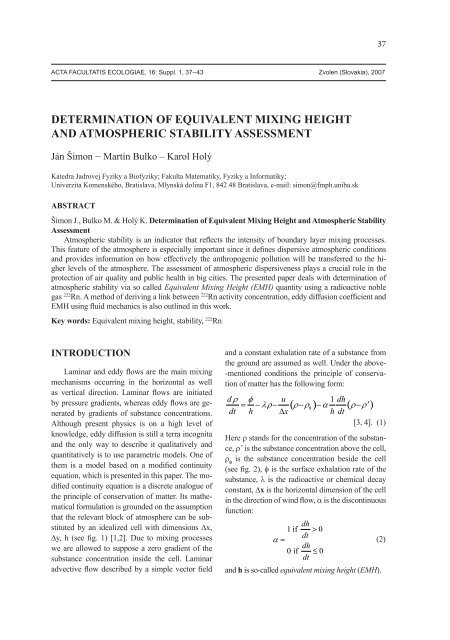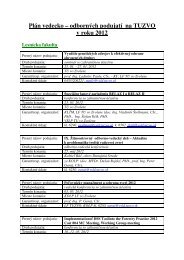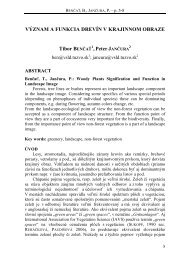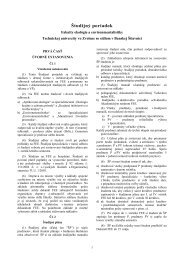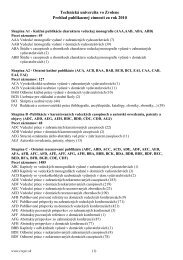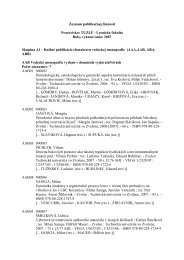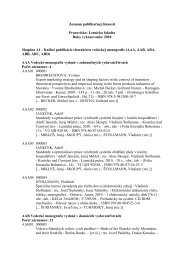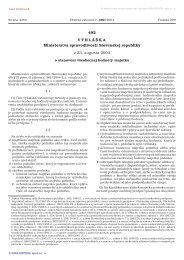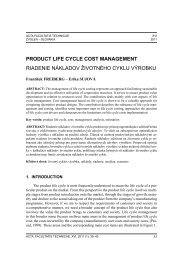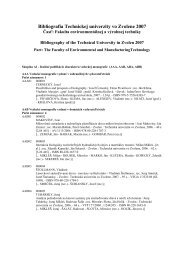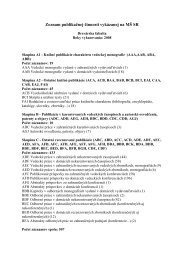Acta Facultatis Ecologiae - Technická univerzita vo Zvolene
Acta Facultatis Ecologiae - Technická univerzita vo Zvolene
Acta Facultatis Ecologiae - Technická univerzita vo Zvolene
- No tags were found...
You also want an ePaper? Increase the reach of your titles
YUMPU automatically turns print PDFs into web optimized ePapers that Google loves.
37ACTA FACULTATIS ECOLOGIAE, 16: Suppl. 1, 37 – 43 Z<strong>vo</strong>len (Slovakia), 2007DETERMINATION OF EQUIVALENT MIXING HEIGHTAND ATMOSPHERIC STABILITY ASSESSMENTJán Šimon − Martin Bulko – Karol HolýKatedra Jadrovej Fyziky a Biofyziky; Fakulta Matematiky, Fyziky a Informatiky;Univerzita Komenského, Bratislava, Mlynská dolina F1, 842 48 Bratislava, e-mail: simon@fmph.uniba.skABSTRACTŠimon J., Bulko M. & Holý K. Determination of Equivalent Mixing Height and Atmospheric StabilityAssessmentAtmospheric stability is an indicator that reflects the intensity of boundary layer mixing processes.This feature of the atmosphere is especially important since it defines dispersive atmospheric conditionsand provides information on how effectively the anthropogenic pollution will be transferred to the higherlevels of the atmosphere. The assessment of atmospheric dispersiveness plays a crucial role in theprotection of air quality and public health in big cities. The presented paper deals with determination ofatmospheric stability via so called Equivalent Mixing Height (EMH) quantity using a radioactive noblegas 222 Rn. A method of deriving a link between 222 Rn activity concentration, eddy diffusion coefficient andEMH using fluid mechanics is also outlined in this work.Key words: Equivalent mixing height, stability, 222 RnINTRODUCTIONLaminar and eddy flows are the main mixingmechanisms occurring in the horizontal as wellas vertical direction. Laminar flows are initiatedby pressure gradients, whereas eddy flows are generatedby gradients of substance concentrations.Although present physics is on a high level ofknowledge, eddy diffusion is still a terra incognitaand the only way to describe it qualitatively andquantitatively is to use parametric models. One ofthem is a model based on a modified continuityequation, which is presented in this paper. The modifiedcontinuity equation is a discrete analogue ofthe principle of conservation of matter. Its mathematicalformulation is grounded on the assumptionthat the relevant block of atmosphere can be substitutedby an idealized cell with dimensions ∆x,∆y, h (see fig. 1) [1,2]. Due to mixing processeswe are allowed to suppose a zero gradient of thesubstance concentration inside the cell. Laminaradvective flow described by a simple vector fieldand a constant exhalation rate of a substance fromthe ground are assumed as well. Under the above--mentioned conditions the principle of conservationof matter has the following form:d r f u 1 dh= − lr− ( r−r0) − a ( r− r′)dt h Dx h dt[3, 4]. (1)Here ρ stands for the concentration of the substance,ρ´ is the substance concentration above the cell,ρ 0is the substance concentration beside the cell(see fig. 2), φ is the surface exhalation rate of thesubstance, λ is the radioactive or chemical decayconstant, ∆x is the horizontal dimension of the cellin the direction of wind flow, α is the discontinuousfunction:dh1 if > 0dta =(2)dh0 if ≤ 0dtand h is so-called equivalent mixing height (EMH).


